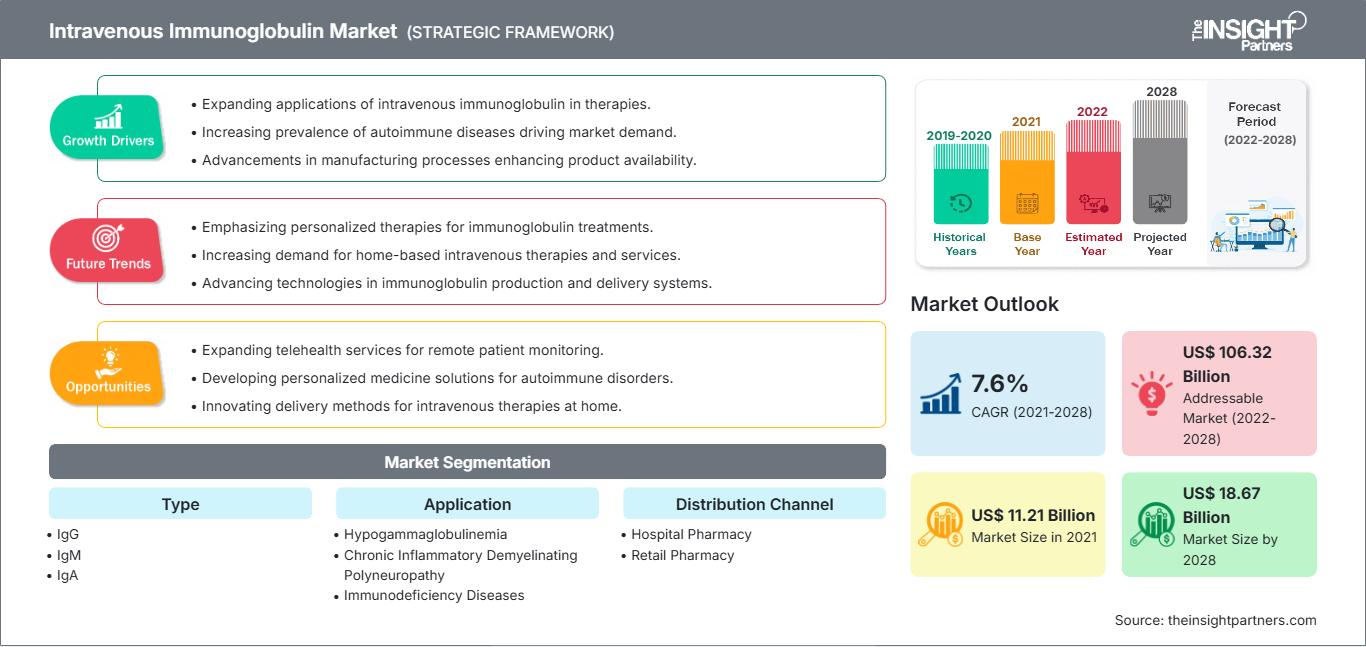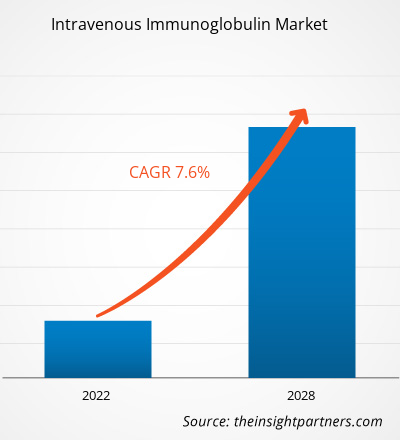Der Markt für intravenöse Immunglobuline hatte im Jahr 2021 einen Wert von 11.206,54 Millionen US-Dollar und wird bis 2028 voraussichtlich einen Wert von 18.672,55 Millionen US-Dollar erreichen; von 2022 bis 2028 wird ein CAGR-Wachstum von 7,6 % erwartet.
Immunglobuline sind vom körpereigenen Immunsystem auf natürliche Weise produzierte Antikörper, die bei der Bekämpfung von Infektionen und Krankheiten helfen. Ein Mangel an Immunglobulin erfordert die externe Verabreichung von Immunglobulinen und wird als Immunglobulinersatztherapie (IgRT) bezeichnet. IgRT kann intravenös und subkutan verabreicht werden. Intravenöses Immunglobulin (IVIg) und subkutanes Immunglobulin (SCIg) werden je nach Indikation und Schweregrad ausgewählt. IVIg wird aus menschlichem Plasma hergestellt. Es enthält Antikörper und wird zur Behandlung einer wachsenden Zahl immunologischer, hämatologischer und neurologischer Erkrankungen eingesetzt.
Der Markt für intravenöse Immunglobuline ist nach Typ, Anwendung, Vertriebskanal, Endverbraucher und geografischer Lage segmentiert. Geografisch unterteilt sich der Markt grob in Nordamerika, Europa, den asiatisch-pazifischen Raum, den Nahen Osten und Afrika sowie Süd- und Mittelamerika. Dieser Bericht bietet Einblicke und eine detaillierte Marktanalyse mit Schwerpunkt auf Parametern wie Markttrends, Marktdynamik und der Wettbewerbsanalyse der weltweit führenden Marktteilnehmer.
Passen Sie diesen Bericht Ihren Anforderungen an
Sie erhalten kostenlos Anpassungen an jedem Bericht, einschließlich Teilen dieses Berichts oder einer Analyse auf Länderebene, eines Excel-Datenpakets sowie tolle Angebote und Rabatte für Start-ups und Universitäten.
Markt für intravenöses Immunglobulin: Strategische Einblicke

- Holen Sie sich die wichtigsten Markttrends aus diesem Bericht.Dieses KOSTENLOSE Beispiel umfasst Datenanalysen, die von Markttrends bis hin zu Schätzungen und Prognosen reichen.
Sie erhalten kostenlos Anpassungen an jedem Bericht, einschließlich Teilen dieses Berichts oder einer Analyse auf Länderebene, eines Excel-Datenpakets sowie tolle Angebote und Rabatte für Start-ups und Universitäten.
Markt für intravenöses Immunglobulin: Strategische Einblicke

- Holen Sie sich die wichtigsten Markttrends aus diesem Bericht.Dieses KOSTENLOSE Beispiel umfasst Datenanalysen, die von Markttrends bis hin zu Schätzungen und Prognosen reichen.
Markteinblicke
Die steigende Prävalenz von Immunschwächekrankheiten und die zunehmende geriatrische Bevölkerung treiben den Markt für intravenöse Immunglobuline an.
Laut dem National Institute of Allergy and Infectious Diseases (NIAID) sind in den USA etwa 500.000 Menschen von über 200 verschiedenen Arten primärer Immunschwächekrankheiten (PIDDs) betroffen. Diese seltenen genetischen Krankheiten können chronisch, schwerwiegend und kostspielig sein. Immunthrombozytopenie (ITP) ist eine Autoimmunblutungsstörung, die durch einen ungewöhnlich niedrigen Blutplättchenspiegel gekennzeichnet ist; dieser Zustand wird als Thrombozytopenie bezeichnet. Laut der Organisation für seltene Krankheiten werden jährlich weltweit etwa 200.000 ITP-Fälle registriert. Laut der Bevölkerungsabteilung der Vereinten Nationen (World Population Prospects 2019) gehören die asiatischen und europäischen Länder zu den ältesten Ländern der Welt, nämlich 65 Jahre und älter. Japan liegt mit 28 % an der Spitze, gefolgt von Italien mit 23 %. Finnland, Portugal und Griechenland gehören zu den fünf Ländern mit einem Anteil älterer Menschen unter 22 %. Viele der mit IVIG behandelten Patienten sind über 60 Jahre alt. Mit zunehmendem Alter nimmt die Fähigkeit zur Produktion von T-Zellen zur Bekämpfung von Krankheiten erheblich ab. Daher ist der Körper älterer Menschen anfälliger für verschiedene Infektionen und Krankheiten, was die Nachfrage nach Immuntherapien mit IVIg erhöht. Daher stärken der Anstieg von Immunschwächekrankheiten und die weltweite Zunahme der geriatrischen Bevölkerung den Markt für intravenöse Immunglobuline.
Typbasierte Erkenntnisse
Basierend auf dem Typ ist der Markt für intravenöse Immunglobuline in IgG, IgM, IgA, IgE und IgD unterteilt. Das Segment der Immunglobuline vom Typ IgG hatte 2021 den größten Marktanteil. Es wird jedoch erwartet, dass das Segment der Handheld-Geräte im Prognosezeitraum aufgrund der breiten Anwendung von IgG bei der Behandlung verschiedener Krankheitskategorien die höchste durchschnittliche jährliche Wachstumsrate (CAGR) verzeichnen wird.
Anwendungsbasierte Erkenntnisse
Basierend auf der Anwendung ist der Markt für intravenöse Immunglobuline in Hypogammaglobulinämie, chronisch inflammatorische demyelinisierende Polyneuropathie, Immunschwächekrankheiten, Myasthenia gravis, multifokale motorische Neuropathie, idiopathische thrombozytopenische Purpura, entzündliche Myopathien, spezifischen Antikörpermangel, Guillain-Barré-Syndrom und andere unterteilt. Im Jahr 2021 hatte das Segment der Immunschwächekrankheiten den größten Marktanteil. Darüber hinaus wird für dasselbe Segment von 2022 bis 2028 aufgrund der zunehmenden Verbreitung von Immunschwächekrankheiten und der zunehmenden FDA-Zulassungen für IVIg-Produkte zur Behandlung von Immunschwäche ein Nachfragewachstum mit der höchsten durchschnittlichen jährlichen Wachstumsrate (CAGR) erwartet.
Einblicke auf der Grundlage von Vertriebskanälen
Basierend auf dem Vertriebskanal ist der Markt für intravenöse Immunglobuline in Krankenhausapotheken, Einzelhandelsapotheken und andere segmentiert. Im Jahr 2021 hielt das Segment der Krankenhausapotheken den größten Marktanteil. Darüber hinaus wird im Apothekensegment von 2022 bis 2028 voraussichtlich die schnellste CAGR-Nachfragesteigerung verzeichnet, was auf die Expansion von Apotheken und die Verlagerung des Verbraucherverhaltens hin zu organisierten Apotheken mit qualitativ hochwertigen Arzneimitteln und Medikamenten zurückzuführen ist.
Endnutzerbasierte Erkenntnisse
Basierend auf dem Endnutzer ist der Markt für intravenöse Immunglobuline in Krankenhäuser, Fachkliniken und andere segmentiert. Im Jahr 2021 hatte das Krankenhaussegment den größten Marktanteil. Darüber hinaus wird im Segment der Fachkliniken von 2022 bis 2028 voraussichtlich die schnellste CAGR-Nachfragesteigerung verzeichnet, was auf die Fortschritte dieser Kliniken bei der Bereitstellung schneller und präziser IgRT für Patienten zurückzuführen ist.
Organische Entwicklungen wie Produktzulassungen sind häufig genutzte Strategien der globalen Akteure auf dem Markt für intravenöse Immunglobuline. Einige der wichtigsten Marktentwicklungen der letzten Zeit sind nachfolgend aufgeführt:
- Im März 2022 gab ADMA Biologics, Inc. die Genehmigung der US-amerikanischen Food and Drug Administration (FDA) bekannt, das Verfallsdatum seiner bei 2–8 °C gelagerten Immunglobulin-Arzneimittelprodukte ASCENIV und BIVIGAM von 24 auf 36 Monate zu verlängern. Die Verlängerung des Verfallsdatums gilt für alle bestehenden ASCENIV- und BIVIGAM-Chargen, die sich derzeit in der kommerziellen Lieferkette befinden, sowie für die zukünftige Produktion von ASCENIV und BIVIGAM in allen Fläschchengrößen und Produktionsskalen sowie für intern und extern abgefüllte Arzneimittel.
- Im Juni 2021 gab Octapharma bekannt, dass Octagam 10 %, ein aus menschlichem Plasma gewonnenes intravenöses Immunglobulin (IVIg), kürzlich in der Europäischen Union (EU) die Zulassung als immunmodulatorische Therapie für Erwachsene mit Dermatomyositis erhalten hat. Nach der EU-Zulassung erhielt Octagam 10 % am 11. Mai 2021 die nationale Zulassung in Deutschland, und die Zulassung in anderen europäischen Mitgliedsstaaten wird in Kürze erwartet.
- Im April 2021 gab ADMA Biologics, Inc. bekannt, dass die US-amerikanische Food and Drug Administration (FDA) den erweiterten Herstellungsprozess des Unternehmens genehmigt hat, der die Fraktionierung und Reinigung eines 4.400 Liter großen Plasmapools für die Herstellung von intravenösem Immunglobulin (IVIG) ermöglicht.
- Im Februar 2020 gab CSL Behring bekannt, dass die US-amerikanische Food and Drug Administration (FDA) Privigen (Intravenöses Immunglobulin (Human), 10 % flüssig) den Orphan-Drug-Status als Prüfpräparat zur Behandlung von systemischer Sklerose (SSc) erteilt hat.
Solche Entwicklungen der Marktteilnehmer treiben die Entwicklung von intravenösen Immunglobulinen voran Markt.
Intravenöses ImmunglobulinRegionale Einblicke in den Markt für intravenöse Immunglobuline
Regionale Einblicke in den Markt für intravenöse Immunglobuline
Die Analysten von The Insight Partners haben die regionalen Trends und Faktoren, die den Markt für intravenöse Immunglobuline im Prognosezeitraum beeinflussen, ausführlich erläutert. In diesem Abschnitt werden auch die Marktsegmente und die geografische Lage in Nordamerika, Europa, dem asiatisch-pazifischen Raum, dem Nahen Osten und Afrika sowie Süd- und Mittelamerika erörtert.
Umfang des Marktberichts über intravenöses Immunglobulin
| Berichtsattribut | Einzelheiten |
|---|---|
| Marktgröße in 2021 | US$ 11.21 Billion |
| Marktgröße nach 2028 | US$ 18.67 Billion |
| Globale CAGR (2021 - 2028) | 7.6% |
| Historische Daten | 2019-2020 |
| Prognosezeitraum | 2022-2028 |
| Abgedeckte Segmente |
By Typ
|
| Abgedeckte Regionen und Länder | Nordamerika
|
| Marktführer und wichtige Unternehmensprofile |
|
Dichte der Marktteilnehmer für intravenöse Immunglobuline: Verständnis ihrer Auswirkungen auf die Geschäftsdynamik
Der Markt für intravenöse Immunglobuline wächst rasant. Dies ist auf die steigende Endverbrauchernachfrage zurückzuführen, die auf Faktoren wie veränderte Verbraucherpräferenzen, technologische Fortschritte und ein stärkeres Bewusstsein für die Produktvorteile zurückzuführen ist. Mit der steigenden Nachfrage erweitern Unternehmen ihr Angebot, entwickeln Innovationen, um den Bedürfnissen der Verbraucher gerecht zu werden, und nutzen neue Trends, was das Marktwachstum weiter ankurbelt.

- Holen Sie sich die Markt für intravenöses Immunglobulin Übersicht der wichtigsten Akteure
Intravenöses Immunglobulin – Marktsegmentierung
Der globale Markt für intravenöses Immunglobulin ist nach Typ, Anwendung, Vertriebskanal, Endverbraucher und Geografie segmentiert. Nach Typ ist der Markt in IgG, IgM, IgA, IgE und IgD segmentiert. Nach Anwendung ist der Markt in Hypogammaglobulinämie, chronisch inflammatorische demyelinisierende Polyneuropathie, Immunschwächekrankheiten, Myasthenia gravis, multifokale motorische Neuropathie, idiopathische thrombozytopenische Purpura, entzündliche Myopathien, spezifischen Antikörpermangel, Guillain-Barré-Syndrom und andere segmentiert. Nach Vertriebskanal ist der Markt in Krankenhausapotheken, Einzelhandelsapotheken und andere segmentiert. Nach Endverbraucher ist der Markt in Krankenhäuser, Fachkliniken und andere segmentiert. Geografisch ist der Markt in Nordamerika, Europa, Asien-Pazifik, Naher Osten und Afrika sowie Süd- und Mittelamerika unterteilt.
Firmenprofile
- Takeda Pharmaceutical Company Limited
- Grifols, SA
- Pfizer Inc.
- ADMA Biologics Inc.
- Bio Products Laboratory Ltd.
- Shanghai RAAS
- Octapharma AG
- Kedrion SpA
- CSL Behring (CSL Limited)
- Prothya Biosolutions BV
- Historische Analyse (2 Jahre), Basisjahr, Prognose (7 Jahre) mit CAGR
- PEST- und SWOT-Analyse
- Marktgröße Wert/Volumen – Global, Regional, Land
- Branchen- und Wettbewerbslandschaft
- Excel-Datensatz
Aktuelle Berichte
Erfahrungsberichte
Grund zum Kauf
- Fundierte Entscheidungsfindung
- Marktdynamik verstehen
- Wettbewerbsanalyse
- Kundeneinblicke
- Marktprognosen
- Risikominimierung
- Strategische Planung
- Investitionsbegründung
- Identifizierung neuer Märkte
- Verbesserung von Marketingstrategien
- Steigerung der Betriebseffizienz
- Anpassung an regulatorische Trends




















 Kostenlose Probe anfordern für - Markt für intravenöses Immunglobulin
Kostenlose Probe anfordern für - Markt für intravenöses Immunglobulin